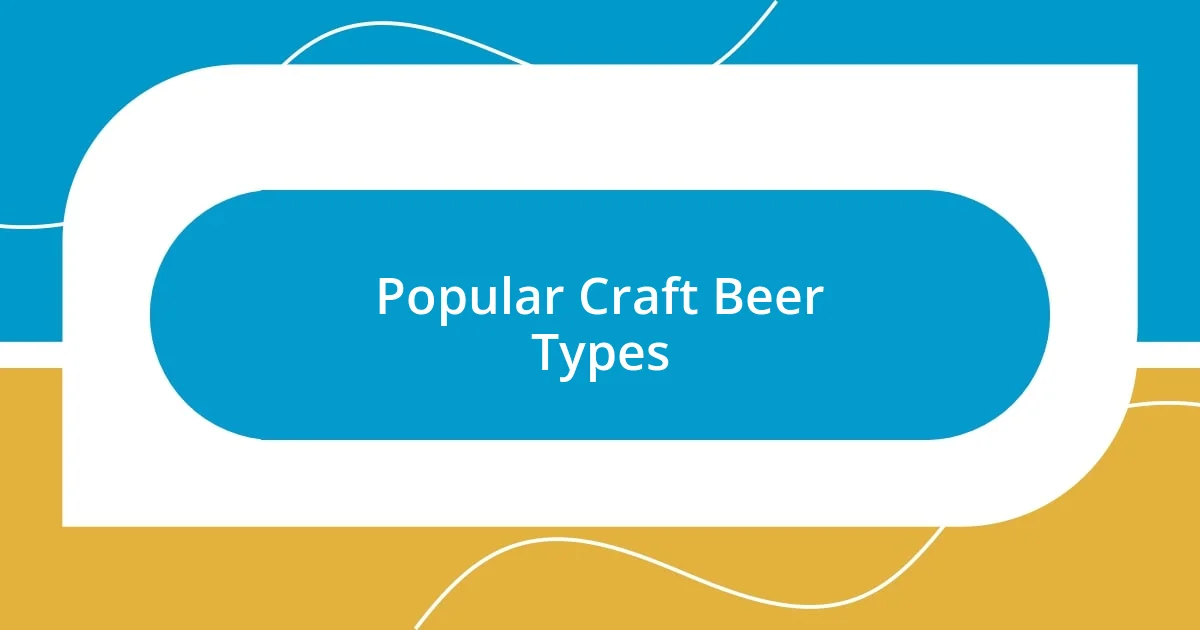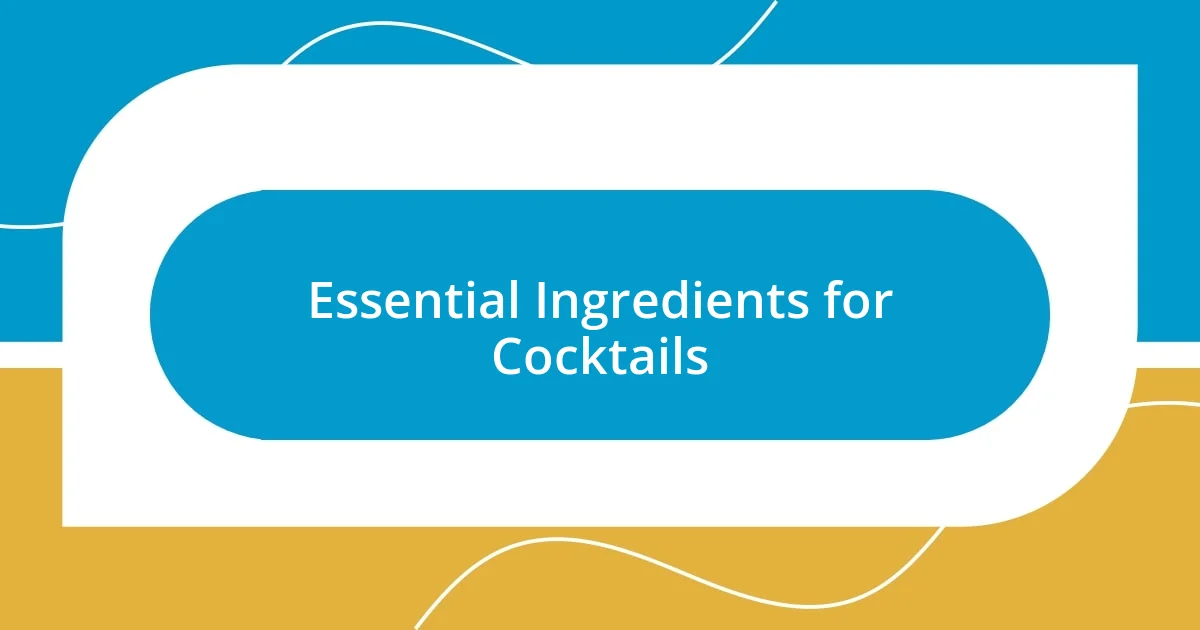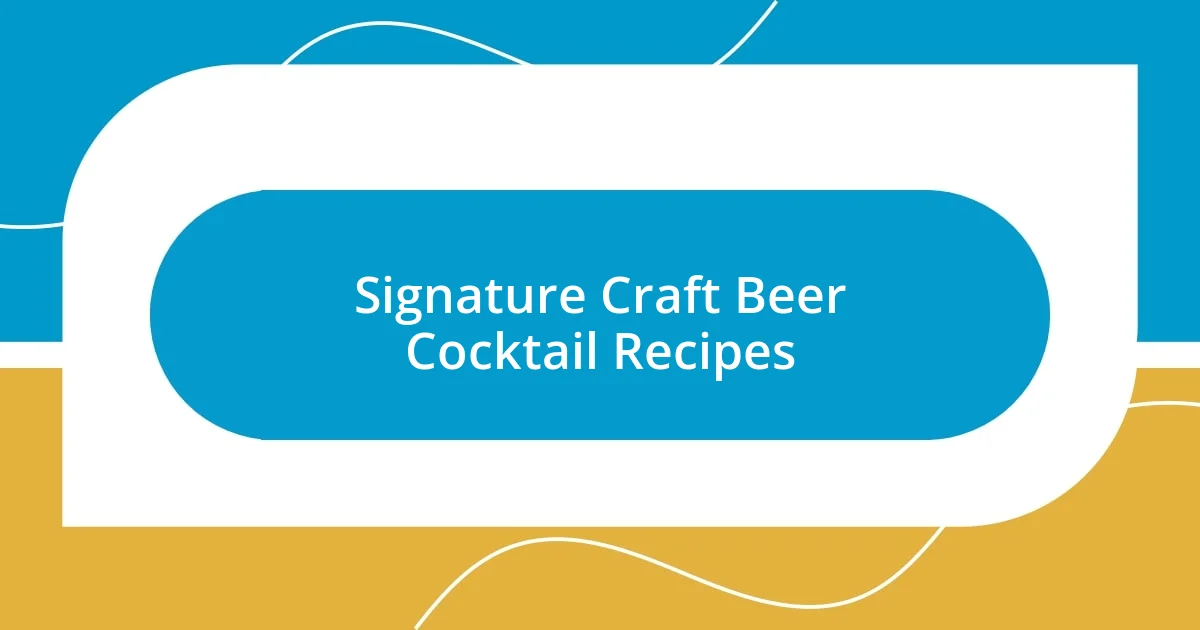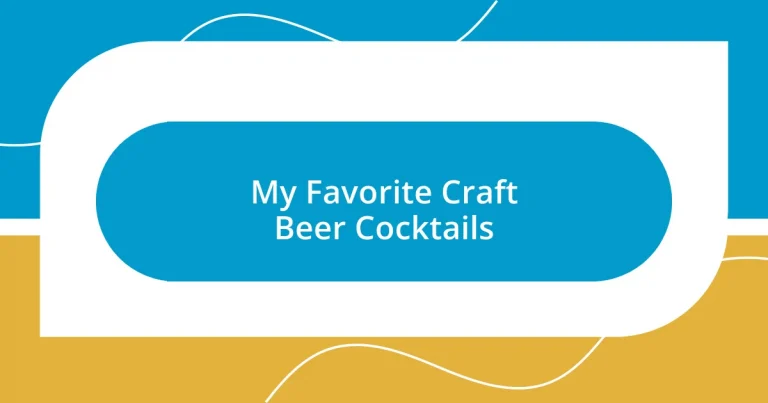Key takeaways:
- Craft beer cocktails combine unique beer flavors with mixers, enhancing creativity and personal enjoyment in mixology.
- Popular craft beer types—such as IPAs, stouts, and wheat beers—provide diverse flavor profiles, enabling exciting cocktail experiments.
- Essential techniques like careful ingredient selection, proper dilution, and attractive garnishing significantly enhance the cocktail experience.

Understanding Craft Beer Cocktails
Craft beer cocktails are a delightful innovation that combines the distinct flavors of craft beers with spirited mixers to create something truly unique. I recall the first time I sipped a beer-based cocktail; it was a refreshing blend of a hoppy IPA and zesty grapefruit juice. That combination was a revelation, making me wonder just how transformative a simple cocktail could be when we introduce the complexity of craft beer.
The beauty of these cocktails lies in their versatility. Imagine pairing a smooth stout with creamy Irish whiskey and a touch of vanilla; it can kindle a warm nostalgia reminiscent of cozy evenings by the fireplace. Doesn’t that just make your heart flutter? The layers of flavors in craft beer cocktails can evoke memories and emotions, making them perfect for any occasion, whether it’s a weekend gathering or a quiet night in.
Mixing craft beer into cocktails not only elevates the drink but also invites creativity. I often experiment with seasonal flavors, using pumpkin ale during fall or light lagers in summer. Each sip turns into an exploration, making the experience more personal and interactive. Isn’t that what cocktails are all about? Discovering new combinations that excite our taste buds and spark joy?

Popular Craft Beer Types
Popular Craft Beer Types encompass a wide variety of flavors and styles, giving cocktail enthusiasts plenty to experiment with. For example, I’ve found that IPAs (India Pale Ales) often become the star of beer cocktails because their bold hop profiles add a punch to any mix. One time, I mixed a crisp, citrus-forward IPA with elderflower liqueur and a splash of soda; it was an instant hit at my backyard barbecue!
Here are some popular craft beer types to consider for your next cocktail adventure:
- India Pale Ales (IPAs): Known for their hoppy bitterness and fruity notes.
- Stouts: Rich, dark beers that often have hints of chocolate or coffee.
- Pale Ales: Balanced with a moderate hoppy flavor, making them versatile.
- Wheat Beers: Light and refreshing, often brewed with additional flavors like fruit.
- Sours: Tart and tangy, these can add a fascinating twist to your cocktails.
Each type has its own character that can open up new avenues for creativity. I once tried a sour ale with pomegranate juice, and it was a flavor explosion that took me completely off guard. It’s those little surprises that make crafting cocktails so rewarding!

Essential Ingredients for Cocktails
When it comes to crafting beer cocktails, the essential ingredients can truly make or break the experience. A solid foundation typically starts with the beer itself—choosing a style that complements your other ingredients is paramount. I remember a particular sunny afternoon when I decided to mix a fruity pale ale with fresh basil and lemon juice, which turned out to be so refreshing that we quickly drank it all. It was a simple yet powerful reminder of how fresh ingredients elevate any drink.
In addition to the beer, mixers play a vital role in harmonizing flavors. Think about ingredients like syrups, juices, or bitters, which can dramatically change the drink’s profile. I’ve had days where I used a hibiscus syrup with a malty porter, resulting in a beautiful combination that reminded me of summer while savoring the depth of a winter’s evening brew. Exploring these flavors can be a delightful journey, allowing for experimentation and personalization in every sip.
| Ingredient Type | Description |
|---|---|
| Craft Beer | The base of your cocktail; should complement your mixers. |
| Mixers | Juices, syrups, or spirits that add flavor and balance. |
| Garnishes | Fresh herbs, fruits, or spices that enhance presentation and aroma. |
| Bitters | Small amounts can heighten the complexity and depth of flavors. |

Techniques for Craft Beer Mixing
Experimenting with different techniques for mixing craft beer can elevate your cocktail game to new heights. One approach I often use is layering flavors. By carefully selecting ingredients and pouring them in a specific order, you can create visually stunning drinks. Imagine a whiskey sour made with a rich stout instead of traditional whiskey; pouring the stout gently over ice allows the layers to create a marbled effect that’s as delightful to the eyes as it is to the palate.
Another technique that has become a staple in my mixing repertoire is the art of dilution. Many people underestimate the importance of this step, but I’ve learned that the right amount of dilution can soften harsh flavors and balance sweet elements. For instance, when I added a splash of lemon juice to a heavy amber ale, letting it sit for a minute before serving, the result was a refreshingly balanced cocktail that was surprisingly smooth. Have you considered the timing of when to ice your drink?
Pairing complementary flavors is also crucial in crafting cocktails. A few weeks ago, I experimented with a juicy wheat beer combined with lavender syrup and a squeeze of lime. The floral notes paired beautifully with the beer’s refreshing profile, resulting in a drink that felt like a warm embrace on a summer evening. It made me wonder: how important is it to trust your instincts when crafting a cocktail? I’ve found that getting a little creative and letting my taste buds lead the way often yields the most rewarding results.

Signature Craft Beer Cocktail Recipes
One of my favorite signature craft beer cocktails is the “Beery Margarita.” Picture this: a crisp lager combined with fresh lime juice, a splash of orange liqueur, and a hint of agave syrup. The first time I mixed this, I was skeptical; could beer really elevate a classic margarita? But that first sip transported me to the beach—refreshing and vibrant. The beer blended seamlessly, offering a lightness that traditional tequila just can’t match.
Another gem in my cocktail repertoire is the “Hoppy Mule.” It’s a fun twist on the classic Moscow Mule, with a hoppy IPA in place of vodka. I remember a rainy weekend when I whipped this up for friends; we were all stuck inside, but one sip of this spicy ginger beer mix made the gloomy day feel like a festive gathering. The hops added a new dimension, making the drink exciting and unforgettable. Don’t you love discovering simple substitutions that elevate an old favorite? It’s moments like these that keep me experimenting.
Lastly, I can’t resist sharing my take on the “Radler Spritz.” It’s a delightful blend of citrusy radler, Aperol, and soda water. I created this on a hot afternoon while entertaining friends, and the vibrant orange hue instantly caught our attention. It was a crowd-pleaser, with guests asking for refills before the first drink was even finished! There’s something magical about sharing a concoction that sparks joy and conversation. Have you ever noticed how a great cocktail can quickly turn a simple gathering into a celebration?

Tips for Pairing and Serving
When it comes to pairing craft beer cocktails, considering the base beer’s flavor profile is essential. I once served a tart Berliner Weisse mixed with strawberry puree at a gathering, and the result was pure happiness. The playful sweetness from the strawberries enhanced the beer’s natural sourness, making for a refreshing drink that was a hit with everyone. It got me thinking: how often do we overlook the importance of balancing bold and subtle flavors in our drinks?
Serving temperature is another critical factor that shouldn’t be ignored. I’ve been amazed at how dramatically a cocktail changes when served at the right temperature. For instance, I experimented with serving a rich stout cocktail chilled rather than at room temperature. The chill allowed the chocolate notes to shine through without being overwhelming, creating a dessert-like experience that was simply delightful. Have you noticed how temperature can transform the drinking experience?
Lastly, garnishing plays a huge role in both presentation and taste. I vividly recall the first time I added a sprig of rosemary to a pale ale cocktail; the aroma was intoxicating! It added an elegant touch that turned my drink into something truly special. Simple garnishes can elevate a cocktail from ordinary to extraordinary and even spark conversation among guests. Isn’t it fascinating how the little details can leave a lasting impression?














